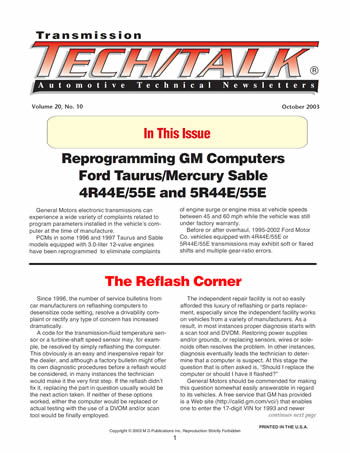Getting Polished With Chrysler’s Buffer
The speed buffer in a GM vehicle (see Figure 1) is a familiar piece of hardware for most transmission technicians. And its operation of taking an AC voltage signal from a speed sensor and converting it to a DC pulse signal for the computer is just as familiar. But what does come as a surprise to many is that Chrysler uses a similar speed-signal strategy for many of its passenger cars and vans.

October 2003 Issue
Issue Summary:
General Motors electronic transmissions can experience a wide variety of complaints related to program parameters installed in the vehicle’s computer at the time of manufacture.
PCMs in some 1996 and 1997 Taurus and Sable models equipped with 3.0-liter 12-valve engines have been reprogrammed to eliminate complaints of engine surge or engine miss at vehicle speeds between 45 and 60 mph while the vehicle was still under factory warranty.
Before or after overhaul, 1995-2002 Ford Motor Co. vehicles equipped with 4R44E/55E or 5R44E/55E transmissions may exhibit soft or flared shifts and multiple gear-ratio errors.

It Ain’t Just Oil
One thing we have seen that is consistent in the repair industry has been an unprecedented explosion of new and changing technology. An amazing number of new transmission and transfer-case designs soon will be appearing in your shop. The ever-increasing use of computer and electronic controls has made all the units more sophisticated, and diagnosis is becoming a stand-alone specialty.

Problems With Metric Cooler-Line Fittings
Few things slow down an R&R job like frozen cooler-line fittings. The metric cooler-line fittings used in Isuzu 4L30 applications and Toyota trucks with A340/30-40LE (see Figure 1) are frustrating enough to make you want to reach for the tubing cutter and start cutting rather than struggle with stubborn lines.

I Hate Noises
By this time, I guess you’ve figured out that this article has to do with noise. I’m sure many of you reading this have your own noise-related horror stories. Noises are difficult to diagnose when you’re standing right there; on the phone, they’re next to impossible. (Have I mentioned that I hate noises?)

